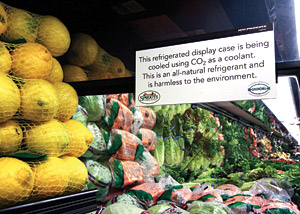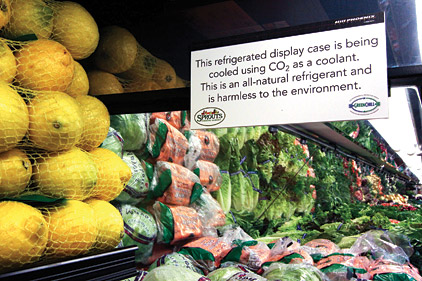
|
| The use of CO2 as a refrigeration refrigerant continues to grow especially in the supermarket sector. |
No technology has stirred up more attention in recent years than use of carbon dioxide (CO2) as a refrigerant in both stationary and mobile HVACR applications. And yet the technology has more people head scratching over it in terms of dealing with the pressures, efficiencies, installation costs, and servicing skills, not to mention how it should be regulated.
In its recent white paper on a range of refrigerants, Emerson Climate Technologies said, “Environmental concerns about the potential direct emissions from HFC-based refrigeration systems have led to legislation and taxation schemes in parts of Europe that favor the usage of carbon dioxide (CO2) as a refrigerant. CO2 is given the designation R-744. CO2 is environmentally benign compared with other refrigerants, is nonflammable, has low toxicity, is widely available, and is a low-first-cost substance.”
While CO2 has first been used in secondary loop and cascade systems, the push continues to make it work in transcritical systems as well. And, here much concern is raised.
Said Emerson, “CO2 has many technical and cost challenges. The low efficiency and cycle complexity are the main limitations; however, CO2 may become used in transport and low-temperature cascade systems, and in some heat pump applications. Whether transcritical or subcritical CO2 systems are considered, CO2 technology cannot be seen as a drop-in replacement for any of the other refrigerants mentioned in this paper. Any application of CO2 requires a thorough assessment of system efficiency, TEWI, life-cycle cost, technical feasibility, reliability, and safety.”
Use on the Increase
But with more and more projects employing CO2 technology, the issues of efficiencies and first costs are being addressed, even if the regulatory aspect remains muddled. One place trying to figure out CO2’s part is California with its California Title 24. According to Doug Scott of VaCom Technologies, CO2 in secondary and cascade cooling is factored into the Green Building Standards of Title 24. Scott told the Food Marketing Institute (FMI) Energy & Store Development conference in September that CO2 offers “a standardized approach for jurisdictions wishing to implement a more stringent code” and allows for “slightly higher energy use” because that can be justified “on lower total emissions.”
The service aspect is also being addressed as training options grow. At the FMI conference, Brian Rees, group technical manager for McAlpine Hussmann Ltd., said, “CO2 is nothing to be afraid of. We have the skills if we’ve worked with CFCs, HCFCs, and HFCs.” In fact, in noting the region he is from, “Australia and New Zealand are the most regulated countries in the region in regards to refrigeration,” yet CO2 is widely used.
Dozens of manufacturers have begun producing technical materials related to use of CO2 such as one from Carel that covers such topics as transcritical, subcritical, pumped, and hybrid CO2 systems, and providing detailed schematics.
AC Applications
In air conditioning applications, Advansor implemented the use of a 1,500-kW heat pump which it said, “is supposed to be the largest CO2 heat pump worldwide.”
It is also getting a look in mobile air conditioning (MAC) as with a German train operator field testing CO2. “The aim is to establish everyday suitability, energy efficiency, and maintenance requirements as compared to systems using HFC-134a. If the results are good, MAC could be deployed on a larger scale.” The caveat was a common one in these early stages of CO2 use. “Offers from component and system manufacturers, however, are scarce.”
The use of CO2 in transcritical applications continues to be addressed by the industry as well as the legalities to use it. As recently as Nov. 8, the supermarket refrigeration equipment manufacturer Hill Phoenix announced that it was “expanding the outreach of CO2 transcritical technology” with its acquisition of Denmark-based Advansor. Scott Martin, director of sustainable technologies, said, “We are already in the middle of pursuing UL permission and ASHRAE approval, and we are pursuing beta test sites. There are already implementations of CO2 transcritical systems in Canada, not UL approved, but we plan to do pilot installations immediately in the U.S. and Canada.”
In September, the Canadian food retailer Sobeys said it has been working with four suppliers to “deploy CO2 technology in stores across Canada. Today Sobeys has made CO2 transcritical technology its national standards.”
Publication date: 12/05/2011



Report Abusive Comment